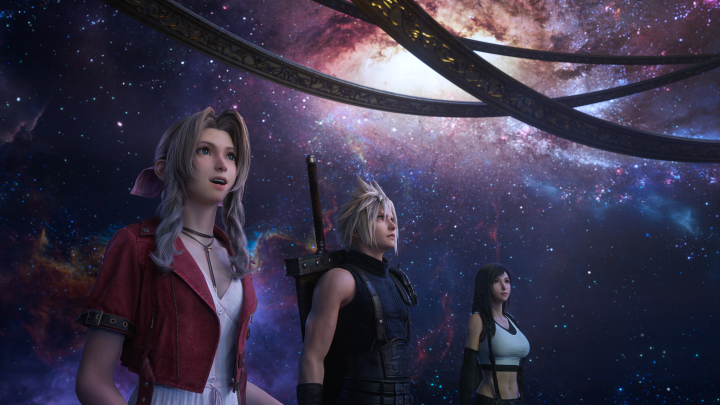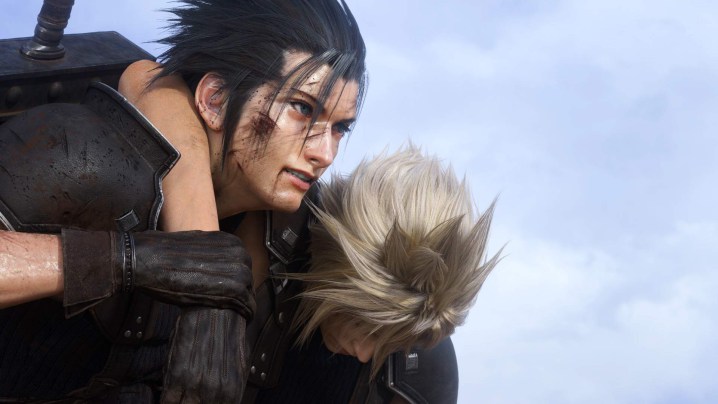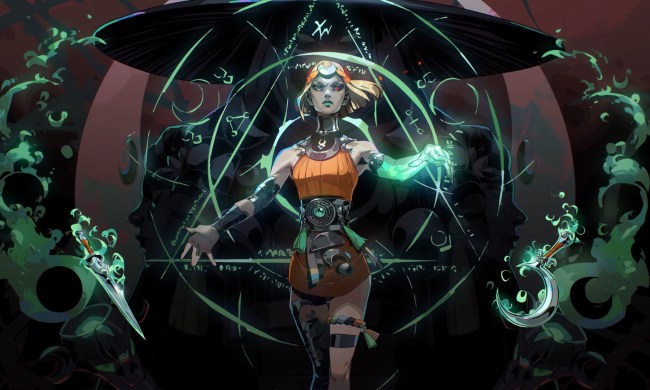
This article contains spoilers for Final Fantasy VII and Final Fantasy VII Rebirth.
Midway through 1997’s Final Fantasy VII, Cloud Strife walks up a small staircase and finds his companion, Aerith, kneeling on a small platform. She’s locked in prayer as holy-looking light streaks in through the windows around her. That serene moment gives way to a shocking tragedy. Aerith looks at Cloud and calmly smiles before the camera pans above her head. A black shadow bursts out of the light above her; it’s the villainous Sephiroth, massive sword in tow. Before Cloud can process what’s happening, Sephiroth plunges his sword through Aerith’s back, killing her.
Her body goes limp as Sephiroth pulls his blade out. There’s no long goodbye. There’s no closure. Aerith dies.
It’s a moment that traumatized an entire generation of gamers. No matter how many times you play Final Fantasy VII, the outcome never changes. Both Cloud and the player controlling him are left feeling like they’ve failed their most valuable party member, a healer who has spent the adventure heroically protecting everyone. It’s a cruel twist of fate, one that leaves a grief-stricken Cloud wondering if could have done anything to save her. Maybe if he’d shown up one second sooner, she’d still be alive.
Rather than dancing around that moment, Final Fantasy VII Rebirth makes that dramatic irony the focus of its story. The remake sequel uses Aerith’s impending fate as a fuel for an emotional, character-driven story about heroes overcoming self-doubt to fight for a better future. That approach comes with a major — and very polarizing — change to the original ending. While it’s sure to infuriate some purists, the grand finale is the exact payoff that Rebirth’s subversive story called for.
A future without destiny
Right from Final Fantasy VII Rebirth’s first chapter, it’s clear that the sequel is entirely built around Aerith’s well-known fate. That’s made abundantly clear right from the start. Its shocking first chapter sees Zack Fair, miraculously alive after escaping his Crisis Core death, trying to rescue Cloud and the gang from Shinra custody. The operation goes all wrong when a helicopter crashes. Zack pulls Aerith out of the wreckage and holds her as her body goes limp, just as it did in the original Final Fantasy VII. For a moment, it appears that Aerith is, once again, dead.
And then, whiplash.
Suddenly, we’re back with Cloud and his pals, including a very much alive Aerith, as they continue their journey to stop Sephiroth. Everyone is carrying on as if nothing’s happened. It’s a maddening moment, and one that Rebirth takes its sweet time following up on. For a long chunk of the story, players are left in the dark. Where’s Zack? Are we dealing with alternate universes? Is Aerith dead? Those questions hang over the peppy adventure for an excruciatingly long time, with answers teased out through a handful of cryptic interstitial scenes.

That moment creates a tension that carries through the entire adventure. Right from the jump, Aerith’s looming death feels like a tangible threat. Even though the party successfully killed the concept of destiny in Final Fantasy VII Remake, that doesn’t mean Aerith is safe. Tragedy can still strike at any moment. But by the same token, it’s not too late to save her either. Despite being the most known spoiler in video game history, Rebirth successfully turns Aerith’s fate into a total mystery.
That dynamic is key to accepting how Rebirth eventually subverts gaming’s most memorable sequence. Strip aside all of its wacky timeline shenanigans and you’ll find that Rebirth tells a grounded, human story about characters who truly believe their futures are unsalvageable. Despite definitively regaining their free will at the end of Remake, each member of the crew has become their own worst enemy. Cloud is convinced that he’s bound to become like Sephiroth, with any warmth succumbing to callous indifference throughout the story. Barret is petrified that his overprotective hold over his daughter, Marlene, will suffocate her. Everyone is dealing with some form of grief or trauma, all of which have planted seeds of self-doubt in their heads.
In Remake, the team had to overcome the God-like manifestation of destiny to regain their free will. In Rebirth, they have to defeat much fiercer foes: themselves. It’s not a low-stakes fight to tame personal anxiety; Aerith’s back is on the line.
A call to action
En route to the City of the Ancients, Rebirth waits to play its full thematic hand until a key sequence with Zack. Midway through the story, we finally get a firmer idea of what’s going on in his asides. Zack finds himself in some sort of alternate timeline apart from the world we know. There, the residents of Midgar face an impending apocalypse — one whose arrival is signaled by a fractured sky. If it takes a while to fully piece that together, it’s because that’s hard to glean from the people around Zack. Everyone in Midgar barely acknowledges the situation or seems particularly interested in saving themselves. They’re resigned to their fate.
Zack isn’t having any of that. In a short speech, he expresses his frustrations with the fact that everyone has given up so easily. That moment reveals his role as a perfect foil to Cloud. Where our blonde hero is brooding and hopeless, Zack is bright-eyed and determined. He has good reason to be too; he defied his own death against all odds. Maybe his version of Gaia is beyond saving. Maybe Midgar’s residents are right to think they are too small to prevent an apocalypse. But that doesn’t mean that everyone should just roll over and let it happen.
Even when faced with the impossible, it’s always worth fighting for a better future.

Zack’s call to action lays the groundwork for Rebirth’s finale. In its penultimate chapter, Aerith’s fate begins to feel more inevitable as the world quite literally narrows. Where most of the game takes place in wide-open biomes where players can stretch their legs and explore freely, Chapter 13 takes the gang to the Temple of the Ancients. It’s a long and linear dungeon that calls back to the restrictive level design of Remake, back when characters were fated to move in one predetermined direction. Rebirth subtly evokes that claustrophobic feeling again as Aerith’s dance with destiny approaches. The tension reaches its boiling point.
The arduous chapter pays off — not with a flashy boss fight, but with key moments of growth for our heroes. At the heart of the temple, each party member undergoes a trial where they’re forced to face their insecurities. They see their pasts: the people they’ve lost, their failures, all of the emotional baggage. It’s a therapeutic moment, one where everyone is forced to pull up the anchors holding them back. By the end of it, there’s a sense that the crew has avoided becoming like the hopeless residents of Zack’s timeline.
With self-defeat cast aside, they’re finally ready for their greatest challenge … even if it means facing another tragedy.
Schrodinger’s Aerith
No matter how intimately you know the original Final Fantasy VII, nothing can prepare you for Rebirth’s final chapter. Rather than simply heading to the City of the Ancients and watching Aerith die, Cloud finds himself in a surreal sequence that almost plays like an RPG version of An American in Paris. It’s a surreal, balletic sequence whose arrival is telegraphed two chapters earlier by a performance of Loveless, an epic play within the Final Fantasy VII universe. It’s not just a fan service for those who’ve always wanted to see a fully realized version of the play; it’s preparing players for the theatrical finale.
Much of the grander plot is revealed in the finale stretch, too. We learn that when something deviates from fate, like Zack surviving a firing squad, it creates a new timeline. Sephiroth’s ultimate plan is to reunite those fractured timelines, cutting out any variables in his ultimate quest. The harder you read into it on a pure plot level, the more holes you’ll find.
But Rebirth’s ending isn’t meant to be taken so literally; it deals in some good old-fashioned symbolism. Before the big ending, Cloud and Aerith find themselves wandering through Zack’s world on something of a date. One sequence sees Cloud going to different street vendors and given a choice of gifts to buy for Aerith. No matter what he chooses, the merchant instead offers him something entirely different. It’s a final manifestation of his ultimate anxiety: that he won’t have a choice in Aerith’s fate.

It’s the last moment of self-reflection Cloud gets before he’s forced to finally face his greatest fear. In a tense sequence following the dreamlike sequence, he enters the City of the Ancients and finds Aerith in a familiar pose. She’s once again praying, surrounded by holy light. Everything begins to play out right on cue. Black feathers fall from the sky as the camera whips up. A black blur on the ceiling quickly gains its form. Sephiroth dives down, sword in hand. History is about to repeat itself … and then, a clash of steel.
Sephiroth’s sword doesn’t pierce Aerith; it’s intercepted by Cloud’s Buster Sword. Decades of catharsis burst out. Aerith is saved.
That relief is short-lived. In a chaotic sequence reminiscent of Michael Haneke’s devious Funny Games, we suddenly flash into a more familiar timeline. Aerith lies bloodied, the sick result of Sephiroth’s timeline reunion. A world-bending clash ensues, where Cloud fights the One Winged Angel alongside both Aerith and, eventually, Zack They overcome Sephiroth, but it’s another timeline fake out. Sephiroth ultimately leaves Rebirth victorious. Zack is sent back to his world, Aerith lies dead, and a grief-stricken Cloud is seemingly left torn between worlds, able to see the dying sky of Zack’s timeline and Aerith’s ghost.
It’s a lot to unpack.
What does it all mean?
LikeRemake’s polarizing ending, the sequence is sure to antagonize Final Fantasy VII purists. A justifiably critical read could leave one miffed with a “multiverse” curveball that softens gaming’s greatest tragedy. Square Enix doesn’t wimp out on killing Aerith, but it does give players the missing closure of her 1997 death. Rebirth has its cake and eats it too by creating a Schrodinger’s Aerith: She’s both saved and killed, alive and dead. There’s even a glimmer of hope that she could be permanently rescued in part three by undoing Sephiroth’s reunion.
Though it may be an emotionally complicated ending for fans, Rebirth couldn’t have ended any other way.
Aerith’s pseudo-death creates a multilayered conclusion for the party’s collective arc, one that’s rich with nuance. Yes, Rebirth is a tale of heroes overcoming self-doubt and learning that they are masters of their own fate, but it’s realistic in its optimism too. Even if you have the power to change something, that doesn’t mean you always can. Aerith’s fatal trip to the City of the Ancients is something of a suicide mission. It’s a long-standing fan theory that’s made more explicit in Rebirth when the Aerith in Zack’s timeline tells Cloud that she’s going to die. Like Zack’s Crisis Core death, she knows she may be sacrificing herself to stop Sephiroth in the long term. That’s her choice to make, not Cloud’s.

We don’t always get the chance to save the people we love. We can try our best to watch out for them, just as Barret worries that he’s obsessively doing so for Marlene, but there’s no way to fully protect someone in this unknown journey of life. That can be frustrating. When I think back to friends I’ve lost, I still have moments where I beat myself up. Since losing one friend to a freak car accident a few years ago, I’ve often wondered if I could have prevented it by inviting them to hang out that day. Maybe that would have pulled them away from the intersection where he was struck by a car. It’s a total fantasy, but it still haunts me from time to time. I’ve had to work through that grief over the past few years, and not let the at-times random inevitability of death stop me from fighting for my loved ones.
Cloud undergoes a similar arc in Rebirth’s finale, though it’s one that plays out on a more supernatural scale. The moment where he temporarily saves Aerith isn’t a physical victory, but a mental one. In that moment, Cloud has fully overcome his self-defeating view of fate. For a brief moment, he sees that he’s not incapable of being a hero. He has the power and determination within himself to save Aerith. That’s not ultimately what happens, but it’s not his fault, nor is it destiny. Life shakes out another way.
The empathetic beauty of Final Fantasy VII Rebirth‘s subversive ending comes in how it allows Cloud to accept that Aerith’s death isn’t a personal failure. He did everything he could to save her, overcoming his own nihilism to protect someone he loves. That’s a heroic act that deserves to be celebrated, even if it doesn’t prevent her murder. Life goes on in the wake of tragedy; you can’t just stop fighting.
At the end of the adventure, there’s a rekindled determination in the grief-stricken Cloud. He is reborn. He’s more motivated than ever to defeat Sephiroth, even if he’s left haunted by Aerith. He won’t become like the sad saps of Midgar, waiting for the inevitable apocalypse to wipe them all away. Cloud is going to fight for a better future and the people he loves right down to his last breath, even if the odds seem impossible. He knows he’s capable of it; he’s seen his blade change history just long enough to accept he has the power.
Life isn’t defined by our past struggles. It’s how you rise to meet the next challenge that matters.
Final Fantasy VII Rebirth is out now on PlayStation 5.



